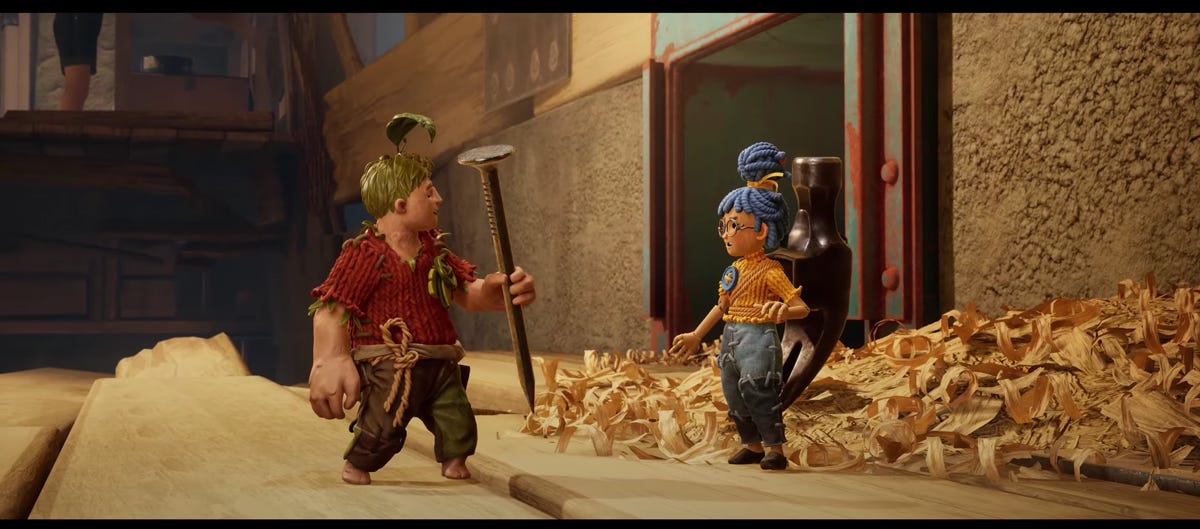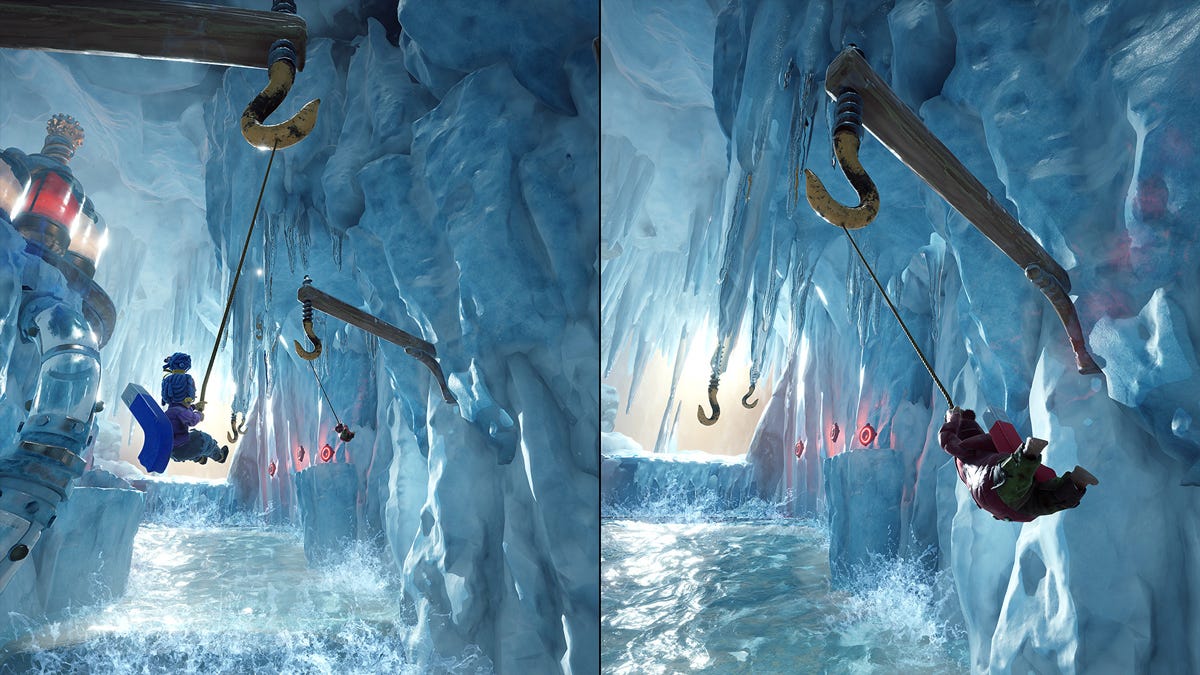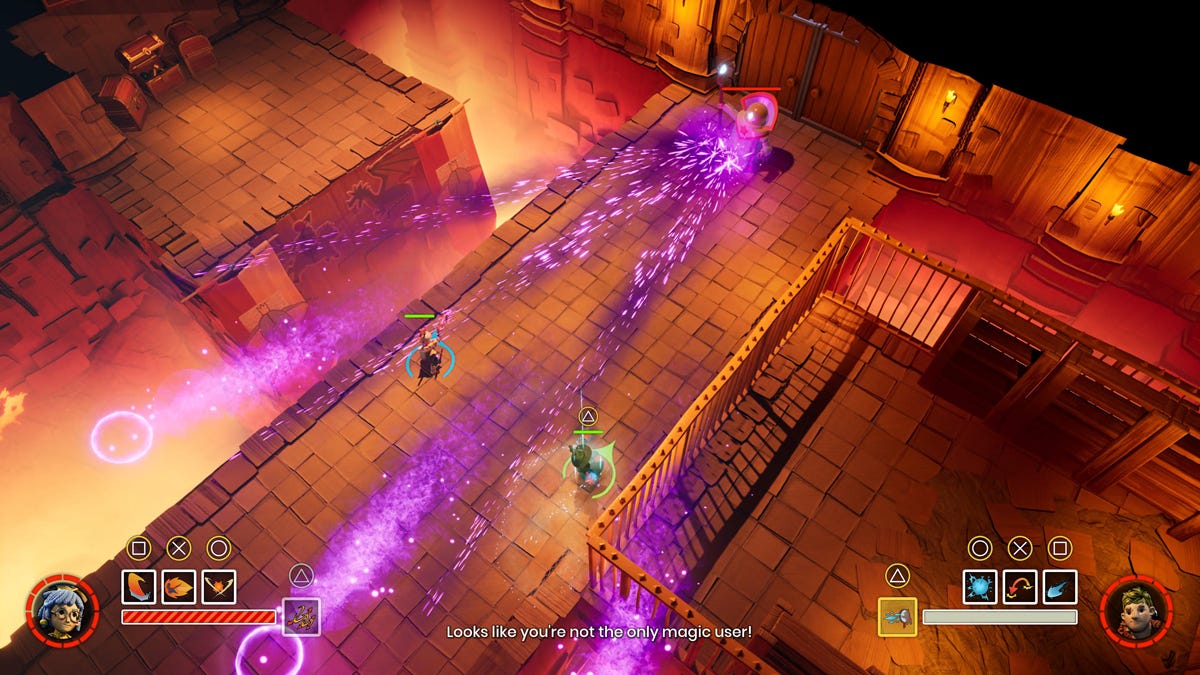It Takes Two: Pt. 2 Gameplay
A best-in-class co-op gaming experience that is never afraid to reinvent itself makes every level of It Takes Two feel unique — and instantly replayable.
When it comes to co-op gameplay, no one does it better than Hazelight. I wasn’t convinced of this after playing A Way Out (which I still enjoyed but wasn’t really immersed within), however, it’s clear the studio wanted to refine and improve upon its gameplay with the experience gained during the production of its first titles. It Takes Two surpasses its predecessor in every way, but gameplay in particular takes a massive step forward.
For starters, the platforming mechanics and absurd nature of the fantasy world in which It Takes Two’s story takes place creates an elevated, and fresher-feeling, experience than I had with the grounded, real-world physics of A Way Out. While I enjoyed breaking out of prison and evading the law by collaborating with my playing partner in the latter title, the gameplay often felt like a watered-down version of a Mafia game (a series that isn’t really heralded for its stellar gameplay).1
On the other hand, It Takes Two felt like an experience all its own. While the double-jumping, wall-hanging, grappling-hook-swinging traversal mechanics have been utilized plenty of times before, these are purely complementary to the real core of the game: tools. Each of It Takes Two’s eight levels presents players with a different tool (or weapon) they need to use to overcome obstacles and solve clever environmental puzzles. Having to get the hang of a new ability or skill every couple of hours, then having to master it in order to defeat some nightmarishly cute boss at the end of the stage, kept the gameplay from every feeling stale.

Because the tool you’re given in each level depends on the character you’re using (e.g., Cody gets nails and May gets a hammer, Cody gets a device that spews incendiary goo and May gets an RPG that shoots matches, Cody and May each get one half of a magnet), and that tool dictates your role in each puzzle/encounter, the game has immediate replayability. As soon as Angela and I finished our most recent playthrough, we traded characters and started a new game to get a completely different experience.
As someone with a short attention span, replayability doesn’t usually do much for me — once I finish a game’s main campaign, I’m almost always thinking about what to play next. But I was excited to basically double my time with It Takes Two because of how fun it is to learn the mechanics of each level and work together with your playing partner to make your way through the game. Multiple tasks required us to take a moment to discuss our strategy, then count down as we announced we would be moving a platform or placing a new anchor on which to swing.
This is co-op gameplay at its best, and (on theme with the game’s story) may help some couples work through their issues with communication (and break up a few others when someone fails to flip a switch in time, sending their partner hurling into a giant fan).
There are certain risks a game-maker assumes when forcing you to play their game in a specific way — a risk that Hazelight Studios is obviously comfortable with, given all of their titles must be played in couch or online co-op. I remember when Hazelight Studio leader Josef Fares, an outspoken and passionate character, made a video announcing that in order to mitigate this risk of the co-op-only game he had made, that people who purchased A Way Out at launch would get a free copy to share with a friend.2
Taking on these kinds of risks is necessary for Hazelight’s games to rise above other co-op experiences on the market. Consider, for example, that a lot of Nintendo’s major releases, especially on the Switch3, are able to be played in both single-player and cooperatively. This functionality is great for friends and families looking to game together, but because you must be able to play these titles in both single- and multi-player formats, you rarely feel like you’re “working together” to overcome puzzles, enemies, etc. — and sometimes when you do, it feels like you’re cheesing the game (e.g., jumping off another characters’ head to get to an otherwise unreachable platform in a 2D Super Mario game). In many of these games, if one player moves onto the next section or screen, the other player(s) are instantly transported along, which always makes the game feel like it's intended to be single-player but others are allowed to join in if they’d like.

Alternatively, Hazelight’s titles get to eschew that feeling that Player 2 is unwelcome. Your playing partner can never get too far ahead of you because regular checkpoints require both players to use their respective abilities to clear. Most scenarios can’t be overcome without some element of collaboration, and there’s always a sense that you need to rely on each other in order to get through any of the challenges It Takes Two presents.
There aren’t many other games out there that give you this sense of truly playing in collaboration with your partner, rather than just in parallel. In both the gameplay ideas conceived and brought to the screen, and the methods with which it forces you to play, Hazelight is never afraid to take risks, especially with It Takes Two, and nearly all of them pay off.
It Takes Two is similar to a few other recent games I’ve loved — namely, Super Mario Bros. Wonder and Astro Bot … I’ll even throw in Annapurna Interactive’s Stray — in that it came from a studio that clearly encouraged its developers to come up with a lot of ideas to put into gameplay. This will be a refrain I keep coming back to throughout this work: Playing it safe and sticking to the status quo can be an effective business strategy, almost guaranteeing a certain number of units sold from a built-in audience (this is why Call of Duty and Assassin's Creed are/used to be on annual release schedules). But this also means a lot of games — especially those in similar genres or the same franchise — feel kind of similar to play.

This makes a game like It Takes Two stand out. Because you’re given a new tool at the outset of each level every 2-3 hours (and usually pick up new abilities to use with it multiple times throughout that stage), the gameplay always feels fresh. And each tool morphs the genre of the game: It Takes Two features levels that play like third- and first-person shooters, a top-down dungeon crawler, and a hack-and-slash fighter, in addition to providing myriad ways to navigate each of the game’s levels (including some impromptu vehicles, such as fidget-spinner hoverboards and tarantulas that act like trusty steeds). Tacked onto the fact that each character gets a completely different role than their playing partner in each of these levels, the game constantly reinvents itself without ever feeling underbaked. The creativity and masterful game-making are apparent in every frame of every level of It Takes Two, and this is the case no matter which character you control.
I’ve been enthused by how well these ambitious platforming games have been received in the past few years (GOTY honors for It Takes Two and Astro Bot, nominations for Super Mario Bros. Wonder and Stray) and hope it means that developers will bring to market more of these premium, high-budget, platforming games that aren’t afraid to think outside the box.
Click here to keep reading about It Takes Two
This whole semi-serious, prison-break vibe seemed like a misunderstanding of co-op games’ most common target audience: couples.
Hazelight recently announced that there would be cross-platform matchmaking in its soon-to-launch Split Fiction, enabling players to team up online regardless of what console they’re playing on — a first for the studio that has always gone out of its way to make its co-op games accessible.
Super Mario 3D World, Kriby and the Forgotten World, Super Mario Bros. Wonder, Pikmin 4, Super Mario Odyssey … the list goes on.


